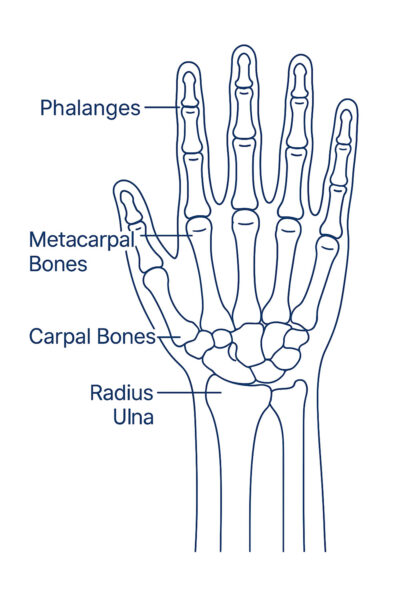 A wrist fracture involves a break in one or more of the bones in your wrist. The plaster cast is not removed until the bone has healed.
A wrist fracture involves a break in one or more of the bones in your wrist. The plaster cast is not removed until the bone has healed.
Bones in the wrist include:
- Phalanges
- Metacarpal Bones
- Carpal Bones
- Radius
- Ulna
What Symptoms May I Experience?
After a wrist fracture, you may notice:
- Pain – often due to stiffness around the injury.
- Swelling – your wrist may swell and feel stiff, especially after the plaster is removed.
- Stiffness and Muscle Weakness – in your shoulder, elbow, or wrist due to lack of use.
- Dry Skin/Excess Hair Growth – from being in a cast for several weeks.
- Difficulty with Daily Tasks – normal activities may be harder to perform.
What Should I Do to Help These Symptoms?
- Pain: Painkillers can help – speak to your pharmacist or GP for advice. Warm water soaks before exercise may relieve pain and stiffness.
- Swelling and Stiffness: Keep your hand above heart level when resting. Move your arm and hand as shown in the exercise section.
- Dry Skin/Excess Hair Growth: Wash your arm and hand with warm water. Use a bland moisturiser (such as aqueous cream) for the first few days. Excess hair growth is normal and will resolve over time.
- Difficulty with Daily Tasks: Build up your strength and flexibility before tackling heavy tasks (e.g., carrying a full kettle or pots).
Useful Exercises
Regaining strength and movement in your wrist is important. These exercises help increase movement and strength, and prevent stiffness in your shoulder and elbow.
- It’s normal to feel some discomfort at first, but this will improve.
- Perform each exercise 5 times every 2 hours. Hold each movement for 5 seconds.
Wrist and Hand Exercises:
- Palm down: move your wrist forward and back.
- Forearm supported: turn your palm up and down.
- Palm vertical: move your wrist side to side.
- Take thumb to little finger.
- Stretch your hand out wide.
- Clench your fingers.
Arm and Shoulder Exercises:
- Clasp hands and lift above your head.
- Reach hand behind your head.
- Reach behind your back.
- Bend and straighten your elbow.
More exercises and videos for wrist hand and finger problems can be found on NHS Inform.
Will My Wrist Get Back to Normal?
- Your ability to carry out daily tasks will improve with time.
- Use your hand for normal tasks as able, but avoid “Hot, Heavy and Dangerous” tasks initially.
- Do not drive until you have recovered good wrist movement.
- You can return to work when you feel able to carry out your duties – this may be immediate for non-manual jobs, or longer for manual work.
- Movement and strength will improve over several months, and may continue to improve for up to a year.
- Continue your exercises and don’t give up.
If you need further help and have not already been referred to a physiotherapist, contact your GP.
Contacts
-
- Fracture Clinic: 01324 566461

